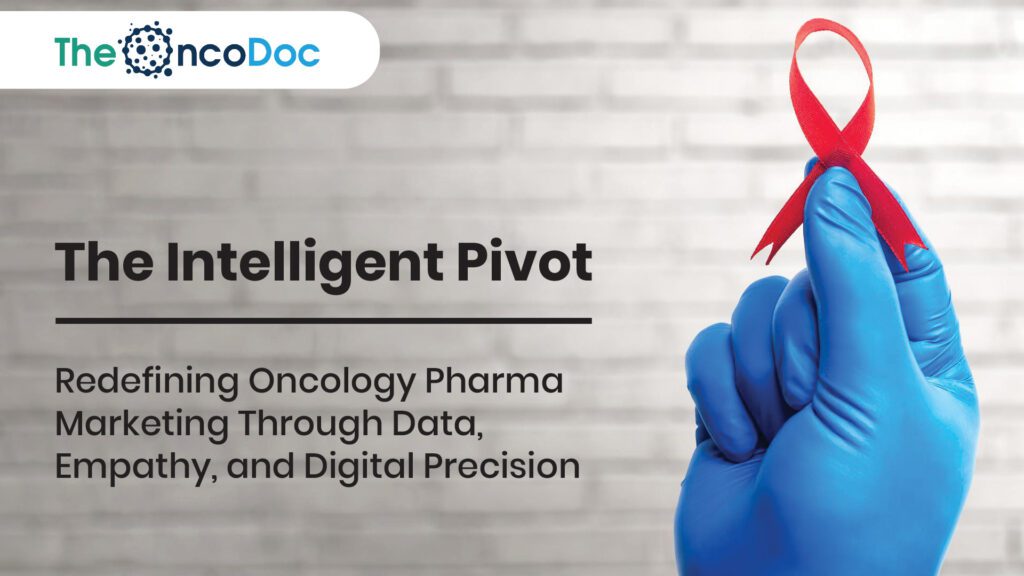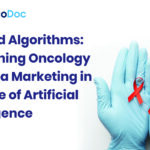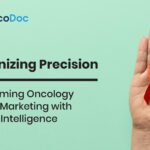Introduction: Oncology Marketing at a Crossroads
The oncology pharmaceutical industry is in the midst of a transformation. As treatment modalities become increasingly sophisticated, ranging from precision oncology and immunotherapy to CAR-T and bispecific antibodies, the expectations of healthcare professionals (HCPs) have evolved accordingly. They are no longer passive recipients of marketing messages but active seekers of value, evidence, and empathy.
Yet, many pharma marketing strategies remain tethered to outdated paradigms, relying on excessive repetition, brand push, and surface-level personalization. Oncology, unlike other therapeutic areas, demands more than awareness; it demands trust, clinical alignment, and outcome-focused engagement.
In this digital-first, data-rich era, pharmaceutical companies must reframe their oncology marketing approach, not as campaigns but as ecosystems. This article outlines how AI, real-world evidence, hyper-personalization, and human-centered design are enabling a new era of intelligent, ethical, and effective oncology pharma marketing.
Section 1: From Mass Messaging to Micro-Engagement; The Evolution of Targeting in Oncology Marketing
In the past, oncology marketing strategies were rooted in broad segmentation, grouping HCPs by specialty or territory. However, India’s oncology landscape is far more nuanced. Oncologists differ not only by region, but also by institutional setting, clinical exposure, digital behavior, and language preferences. This complexity demands a smarter, more personalized approach.
With the advent of machine learning and behavioral analytics, pharma marketers now have the tools to implement microtargeting strategies that deliver highly relevant content tailored to individual clinician needs.
Micro-Engagement Strategies Include:
- Behavioral AI segmentation: Leveraging patterns such as preferred journals, participation in virtual CMEs, and patient case load to categorize oncologists more precisely.
- Role-specific content delivery: Offering customized assets, e.g., treatment guidelines for general oncologists, payer updates for administrators, and MoA visuals for trainees.
- Optimized communication timing: AI-driven algorithms predict the most effective days and hours for engagement based on historical interaction data.
By moving from generic messaging to contextual communication, pharma companies are seeing substantial improvements in digital performance. Open rates, session durations, and content consumption are rising, because relevance breeds responsiveness.
This transition isn’t just about using better tools, it’s about respecting the diversity of oncology professionals and delivering information that aligns with their workflow, priorities, and learning styles. In a specialty where time is scarce and trust is critical, precision is no longer optional, it’s essential.
Section 2: Humanizing the Algorithm; Empathy-Driven Content
AI and data may be the engines of modern marketing, but empathy is the steering wheel. In oncology, where patients often face life-altering diagnoses, oncologists appreciate content that acknowledges the emotional and ethical weight of their decisions.
Key Tactics for Empathy-Driven Messaging:
- Use of narrative medicine: Case-based stories with real patient outcomes evoke relatability while still delivering clinical insights.
- Inclusive imagery and language: Avoid Western-centric visuals. Use culturally relevant and gender-diverse representations.
- Cognitive load design: Oncology professionals often multitask. Bite-sized content with intuitive navigation helps reduce mental fatigue.
These numbers underscore a shift: oncologists prefer information that blends scientific rigor with human nuance.
Section 3: Localized Strategy, Global Insights; Winning in India’s Oncology Landscape
India is not a monolith. From AIIMS Delhi to regional cancer centers in Guwahati, the needs and resources of oncologists vary dramatically. Hence, “Think global, act local” must become more than a slogan.
Localization Strategies for Indian Oncology Marketing:
- Multilingual communication: Use AI-driven language models to deliver regional language support, especially in Tier 2 and Tier 3 cities.
- Geographic epidemiology mapping: AI identifies regional cancer incidence trends (e.g., high head-and-neck cases in North India) and aligns content accordingly.
- Therapy affordability insights: Address local pricing issues, government schemes, and generic availability in communication strategy.
These barriers reveal a content opportunity: marketers must support oncologists not just clinically but contextually.
Section 4: The Era of Intelligent Content; AI for Optimization and Relevance
Marketing automation is not new, but predictive optimization is. Pharma teams can now pre-test digital campaigns in silico, simulate open and drop-off rates, and refine before deployment.
Tools Empowering Intelligent Content Delivery:
- Heatmap analysis: Tracks engagement zones on digital assets to refine layout.
- A/B testing at scale: AI automatically tests multiple variants and chooses winners based on real-time metrics.
- Feedback loops from CRM platforms: Veeva, Salesforce, and other CRM systems now integrate NLU (Natural Language Understanding) for nuanced HCP sentiment analysis.
The data speaks clearly: personalization isn’t optional, it’s foundational.
Section 5: Enhancing Referral Networks through AI Dashboards
Delayed referrals remain a critical pain point in oncology. Many patients in India reach tertiary care centers at advanced stages due to inefficient referral chains.
Pharma marketers can now enable predictive referral pathways through AI-powered dashboards that:
- Map oncology centers and diagnostic hubs by region
- Track average time to diagnosis by cancer type
- Highlight patterns where referral breakdowns are common
- Facilitate HCP-to-HCP connection tools (e.g., e-referral cards)
By offering these tools, pharma brands position themselves not as product sellers, but as system enablers.
Section 6: Measuring What Matters; From Engagement Metrics to Real-World Outcomes
In the evolving landscape of oncology pharma marketing, traditional metrics like impressions and click-through rates no longer suffice. True success is now measured by the depth of impact, not just the breadth of reach. Forward-thinking pharma brands are shifting their focus toward indicators that reflect clinical relevance and behavioral influence.
Key Impact Metrics Include:
- Knowledge Retention: Assessing learning through pre- and post-engagement quizzes to ensure content delivers lasting educational value.
- Therapeutic Confidence Uplift: Measuring whether clinicians feel more assured in prescribing decisions after interacting with digital content.
- Referral Pathway Activation: Tracking increases in timely referrals and early-stage diagnoses driven by awareness and education campaigns.
- Patient-Centric Proxies: Evaluating downstream metrics such as medication adherence, time-to-treatment initiation, and continuity of care.
Advanced Tools Powering Outcome-Based Measurement:
- Sentiment analysis via NLP (Natural Language Processing): Interpreting qualitative feedback to understand HCP perception.
- Multi-touch attribution modeling: Mapping which touchpoints, webinars, emails, peer discussions, drive decision-making.
- Real-world evidence (RWE) dashboards: Integrating population-level health data to assess campaign impact on clinical practice patterns.
This outcomes-focused approach enables pharma marketers to demonstrate real value to clinicians and healthcare systems. In oncology, where every informed decision can profoundly affect a patient’s life, the ultimate marketing metric is not a click, but a change in care.
Section 7: Ethical Intelligence; Upholding Integrity in a Digitally Enabled Oncology Landscape
As oncology pharma marketing becomes increasingly data-driven and digitally sophisticated, the ethical stakes rise accordingly. Digital tools offer immense potential, but also introduce new gray areas that require vigilant oversight. In India, frameworks like the UCPMP (Uniform Code for Pharmaceutical Marketing Practices) and global standards such as the IFPMA Code of Practice guide ethical conduct. However, their application in digital formats, from AI-generated content to real-time engagement tracking, requires proactive interpretation and enforcement.
Key Ethical Imperatives in Oncology Pharma Marketing:
- Maintain clinical neutrality: All content must support informed decision-making, not steer prescribing behavior.
- Ensure transparent sponsorship: Clearly identify branded or sponsored material, especially on educational platforms.
- Protect patient confidentiality: Refrain from collecting, storing, or analyzing personally identifiable patient data through apps, tools, or CRM systems.
- Mandate content oversight: Every digital asset, from webinars to chatbot scripts, must be reviewed by both medical affairs and compliance teams.
In oncology, where patient lives hang in balance and trust is hard-won, ethical lapses are not just regulatory risks, they are reputational threats. The consequences of overstepping digital boundaries can erode years of credibility. That’s why companies must embed ethical intelligence into every stage of digital engagement, design, deployment, and measurement.
True innovation in oncology marketing isn’t just about using advanced technology, it’s about using it responsibly, transparently, and in service of better care.
Section 8: Reinventing the Sales Rep, From Brand Messenger to Digital Engagement Partner
While the traditional sales rep remains a vital part of pharma engagement, their role in oncology is undergoing a significant evolution. In an increasingly digital-first environment, the modern oncology representative must bridge the physical and virtual, blending clinical knowledge with digital agility to meet oncologists’ rising expectations for relevance and value.
The Future-Ready Oncology Sales Rep Is:
- Digitally equipped: Leveraging tablets, AI-enabled CRM systems, and content automation tools to deliver personalized, real-time information during engagements.
- Behaviorally informed: Arriving with insights into what specific content a physician has previously consumed, be it a webinar, case study, or infographic, enabling more meaningful conversations.
- Value-driven: Shifting focus from product promotion to professional support by sharing accredited learning modules, diagnostics access pathways, and patient-centric resources.
This hybrid model, where reps complement digital touchpoints rather than compete with them, is proving effective. As per recent IQVIA data, HCP access rates, which declined sharply post-pandemic, are now rebounding in response to more contextual, digitally enhanced interactions.
Oncology reps today are expected to be more than brand detailers; they must be strategic partners who understand the clinician’s workflow, digital preferences, and real-world practice challenges. By evolving into digital concierges, reps can strengthen trust, reduce friction, and deliver lasting value, redefining the relevance of field engagement in the oncology marketing mix.
Section 9: Future Outlook; The Road Ahead for Oncology Pharma Marketing
By 2030, oncology pharma marketing will have undergone a seismic transformation, moving far beyond today’s multichannel approaches into an era defined by immersive technology, adaptive content, and real-time personalization. As clinician expectations grow and digital health ecosystems mature, pharma marketers must embrace innovation not as a tactic, but as a strategic imperative.
Key Shifts That Will Redefine Oncology Marketing:
- Conversational AI and voice interfaces: Replacing static content portals with intelligent, dialogue-based tools that deliver insights on demand.
- Augmented Reality (AR) integration: Enabling immersive visualization of complex mechanisms of action, particularly useful in explaining novel therapies like CAR-T or bispecific antibodies.
- Dynamic CME credit systems: Accrediting clinicians in real time based on engagement with learning content, driven by behavior, not just attendance.
- National cancer registry integration: Using real-time epidemiological data to localize messaging, align campaigns with incidence trends, and support early diagnosis initiatives.
This future will reward companies that build digital fluency today, not just through platforms and tools, but by upskilling their field force, medical affairs, and marketing teams to think in terms of value creation over volume delivery.
The pharma brands that thrive in this new landscape will be those that combine technology with purpose, becoming proactive contributors to the oncology care continuum, not just messengers. The next frontier of oncology marketing isn’t about doing more, it’s about doing better, faster, and more intelligently.
Conclusion: From Messaging to Meaningful Collaboration
In oncology, where decisions carry profound clinical and emotional weight, superficial engagement holds no ground. This space demands more, more relevance, more credibility, and more commitment to shared outcomes. Pharma marketers who recognize this shift and respond with empathy, evidence, and intelligent technology will transcend the role of mere product promoters.
They will be seen as collaborative partners, trusted contributors to the oncology care journey. By enabling early diagnosis, supporting therapeutic decision-making, and delivering clinically aligned, timely content, marketers can help oncologists do what they do best: provide better care.
As every digital touchpoint increasingly influences medical choices, the responsibility to engage with purpose grows. The future belongs to those who balance AI-powered precision with human-centered intent, using data not just to optimize campaigns, but to build lasting trust.
This evolution isn’t about adding more noise, it’s about creating clarity, confidence, and connection. When pharma marketing aligns itself with the realities of oncology practice, offering value instead of volume, it stops being promotional and starts becoming transformational.
Success will no longer be measured in clicks and impressions, but in relationships built, knowledge shared, and patient lives impacted. This is the true promise of oncology pharma marketing’s next chapter, not louder messages, but deeper meaning.
The Oncodoc team is a group of passionate healthcare and marketing professionals dedicated to delivering accurate, engaging, and impactful content. With expertise across medical research, digital strategy, and clinical communication, the team focuses on empowering healthcare professionals and patients alike. Through evidence-based insights and innovative storytelling, Hidoc aims to bridge the gap between medicine and digital engagement, promoting wellness and informed decision-making.



